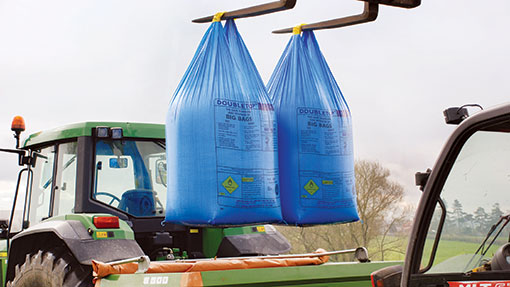Ten top tips for moving big bags on farm

Bulk bags are an essential means of moving seed and fertiliser, and with 1t bags costing in excess of £500 then failures are costly and hazardous. Luke Casswell looks at how to avoid any risks ahead in a busy spring.
Nearly all big bag failures on farm are due to inappropriate lifting or handling, and with high costs and health and safety key concerns growers should be well aware of careful handling this year.
Spring seed and fertilisers are being transported en masse across the country in preparation for a busy period for arable growers, and while failure is not common it can nearly always be avoided.
See also: Know the law when farming near footpaths
Transport from the manufacturer via filling plants and trucks and then to the field usually means a minimum of four movements before the contents of the bag are discharged and ready for use.
Top tips
- Always inspect the lifting tines (or hook) on any machinery you intend to use to lift a fertiliser or seed bag for damage. Look out for burs or sharp edges to the top and bottom of the tines – as these can lead to the bag handles being damaged when lifting and moving the bags.
- Inspect the handle of each bag before lifting to ensure that there is no damage to the bag handle. If there is obvious damage don’t attempt to lift the bag without ensuring that you have taken adequate steps to secure the area of the bag handle with an additional lifting device, such as rope.
- The lifting loops should be positioned according to the manufacturer’s instructions.
- Lift the bag and keep the tines parallel to the ground or as near as possible at all times.
- Don’t tilt the tines and allow the bag to slide down them, as if there are any sharp edges or burs, they will cut or rip the handles, potentially causing the bag to fail.
- Make sure there is nobody standing underneath a bag when lifting or discharging its contents.
- Avoid leaving bags outside or uncovered over any period of time, as damage is likely to occur.
- Do not travel long distances over uneven and rough ground with a bag suspended from tines.
- If bags have twin handles (especially seed bags), ensure that the twin handles are securely tied together before lifting, and if necessary use an additional tie to secure the handles.
- Don’t slide lifting tines along the ground; this only serves to sharpen them, making them more likely to cut a bag handle in the future.
Greif Flexibles, in Thirsk, North Yorkshire, produced more than five million flexible intermediate bulk container (FIBC) bags for fertiliser and seed last year and predicts there will be well in excess of 30 million individual bag movements this year.
The dangers of handling these bags are well documented, and much has been done in recent years to prevent any accidents from occurring. However during such a busy period for growers, they are being reminded of the possible perils of dealing with them.
Trevor Grand, general manager at Greif Flexibles, says growers need to spend more time when handling bags in order to prevent any accidents.
“Sometimes not enough care is taken to check both the bags and the lifting equipment intended for use on farm because of time pressures in the busy spring period,” he explains.
Mr Grand who has more than 30 years’ experience in the industry believes growers can save money and avoid any unnecessary risk by taking simple steps when handling them.
“It’s nearly always avoidable. If there is any issue with the bag this will usually be seen early on,” he says.
“Any failure due to faulty manufacture is most likely to occur at the filling plant rather than at the end user. Failure at the end user is usually caused by poor handling,” Mr Grand adds.
Main issues
The UK fertiliser market uses three sizes of bag, 500kg, 600kg and 1,000kg. One of the main problems growers experience is not lifting the bag high enough when moving causing the base or side of the bag to drag along the ground, according to Mr Grand.
Bags have two basic constructions with fertiliser bags having just one handle, whereas seed bags can have a single handle as well as twin handles (for ease of filling) that are tied together forming a single handle.
Another common issue is puncturing the fabric of the bag with the lifting tines when aiming for these handles. This is usually due to bad driving of machinery when attempting to lift the bag.

When put under load, the polypropylene tape that the bag is made from elongates and then narrows prior to failing. This is the complete opposite of what happens when tapes are cut. It is, therefore, very easy to determine the reason for failure, according to Mr Grand.
“It’s worth investing in the correct equipment to lift and move bags on farm. The additional cost is marginal as compared with the cost of both seed and fertiliser annually,” he says.
“If looked after correctly, they will last for many decades. Using the correct equipment will save time, money and help prevent injury,” he adds.

